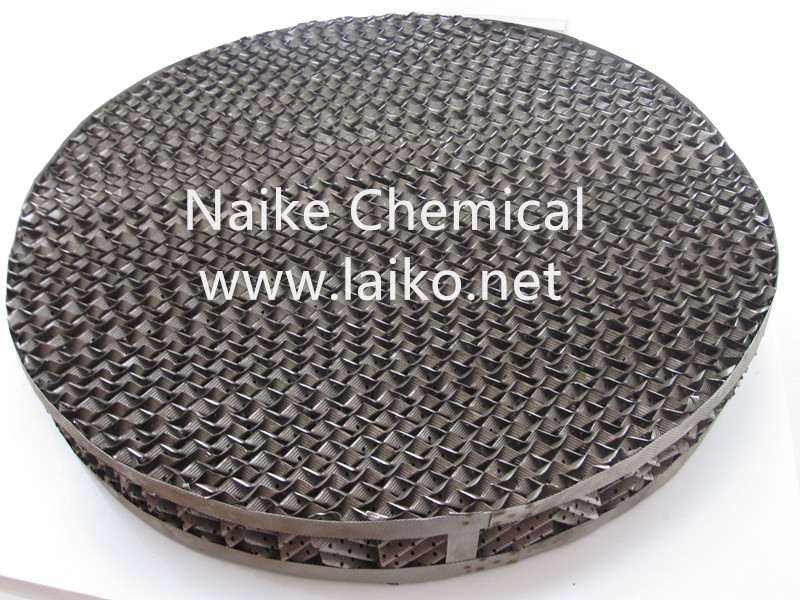A Select Guide to Types of Structured Packing
Structured packing means it is neatly stacked in a tower and arranged according to a uniform geometric figure. It is widely used due to its advantages of large specific surface area, small pressure drop, uniform fluid distribution, and high mass transfer and heat transfer efficiency. Metal-structured packing was first developed, followed by plastic structured packing, ceramic-structured packing, and carbon fiber structured packing.
Types of Structured Packing
1. According to its structural characteristics
can be divided into two categories: corrugated and non-corrugated. The former is divided into the vertical corrugated type and horizontal corrugated type; the latter is divided into grid type and plate type.
The most widely used structured packing is vertical corrugated packing. Vertical corrugated packing is divided into plate corrugated type and mesh corrugated type. In the specification and model representation of corrugated packing, the numbers generally represent the value of its specific surface area, and the letters X and Y represent the corrugated inclination angle of 30°C and 45°C respectively. For example, 400X means that the corrugated packing has a specific surface area of 400m2/m3 and a corrugated inclination of 30°C. The pressure drop of the X-type packing is small; the mass transfer performance of the Y-type packing is better.
2. According to the material type
can be divided into metal structured packing, ceramic structured packing, and plastic structured packing.
Metal structured packing
can be made of various metal materials, such as low carbon steel, stainless steel, Monel alloy, titanium alloy, etc. Stainless steel structured packing is the most popular because of its excellent corrosion resistance, rust resistance, and durability. Metal structured packing has different packing types, which can be divided into wire mesh structured packing and perforated plate structured packing.
has low pressure and high separation efficiency, and is the most widely used of all metal structured packings. Suitable for precision distillation and vacuum distillation units.
Porous plate structured packing is perforated to form a series of 5mm holes, which are then corrugated. This design allows for even distribution of the liquid. In addition, it can improve the surface wettability of structured packing. Porous plate structured packing provides high strength, excellent corrosion, and rust resistance for large diameter columns and high liquid load applications.
Ceramic structured packing
Ceramic structured packing consists of many packing elements of similar geometric design. The geometric design is a series of corrugated sheets placed in parallel. Ceramic structured packing has high filtration and separation efficiency to suit complex applications. It also features low-pressure drop, increased operating flexibility, minimal amplification, and maximum liquid handling. Ceramic structured packings are available in round or rectangular shapes to suit different applications.
Plastic structured packing
can be divided into wire mesh packing and plate packing. Wire mesh packing is made of PP and PE material, and board packing is made of PP or PVDF material. Openings can be added to the plate to improve mass transfer efficiency. Similar to ceramic structured packing and metal structured packing, plastic structured packing can also be made in a round or rectangular shape. Special shapes can be customized.

Advantages of Structured Packing
Low-pressure drop: Compared to other packing options, structured packing, especially gauze packing, offers very low-pressure drop and is a better choice for more volatile chemicals.
Large surface area: In the column packing, there needs to be a lot of opportunity for liquid and vapor contact. The best way to do this is to spread the liquid into a thin film, which structured packing does better than any other packing method.
High Efficiency: Structured packing has excellent separation and filtration efficiency compared to trays and . This means more filtration can be achieved with shorter columns.
High Capacity: The tightly organized internal structure of structured packing enables columns to be more efficient and pack more volume than other packing types. This increased capacity also increases operating costs and rates.
Maximize liquid and gas flow: Structured packing is designed to handle larger flow rates than bulk packing, making it more suitable for high flow rates.
In addition to these advantages, structured packing tends to be more resistant to corrosion and temperature than another packing.
However, structured packing produced by is not the best choice for every application. It tends to be more expensive than another packing due to the quality of materials and manufacturing. This makes it a less cost-effective option for some applications. In addition, structured packaging techniques are more susceptible to problems associated with misallocation.



